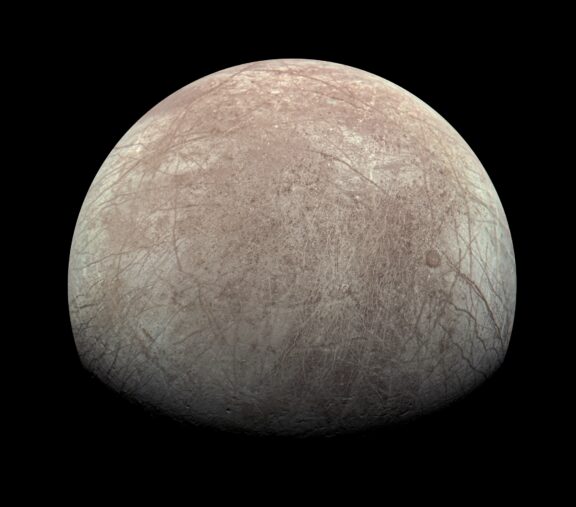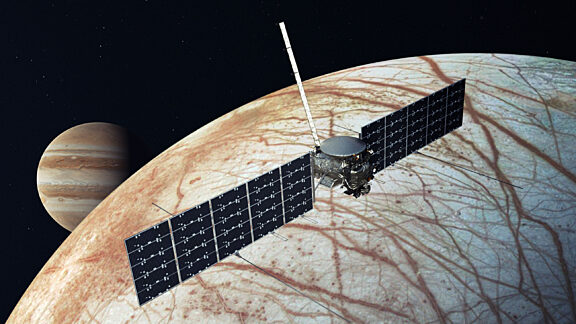Europa Clipper, a mission to Jupiter's icy moon
Highlights
- Jupiter's moon Europa hosts a gigantic saltwater ocean underneath a thick shell of ice.
- Europa may have everything needed to host life as we know it.
- NASA's Europa Clipper mission launched on Oct. 14, 2024, and will arrive at Jupiter in 2030 to determine whether Europa, and other worlds like it, could support life.
Why send a spacecraft to Europa?
Beneath a thick shell of ice, Jupiter's moon Europa hosts a massive ocean that may be able to host life. Its salty ocean could have everything needed for a thriving ecosystem: energy, liquid water, and all the basic chemical ingredients for life as we know it. To find out more, NASA is sending the Europa Clipper mission to perform several close flybys of the Moon and investigate it in detail. This will be the first dedicated mission to explore a world with a global ocean besides Earth. By exploring Europa’s potential to host life, Europa Clipper will help scientists better understand the possibility of life on other worlds with subsurface oceans, including even those outside of the Solar System.

Europa’s salty ocean is estimated to contain more than twice the amount of water on Earth. But all of that water could be locked under the moon’s icy shell, which may stretch anywhere from just 3 kilometers (about 2 miles) wide to over 30 kilometers (19 miles). Though no sunlight could reach through that shell to power life, vents that release heat from the moon's interior could exist on its ocean floor. Similar vents at the bottom of Earth's oceans teem with life. Some scientists even think these vents could have been where life originally began on our planet.
Europa’s ocean might get fed from both above and below. At the ocean floor, Europa’s rocky interior could slowly churn and expose new material to any life present, while at the other side of the ocean, the moon’s icy shell could transport molecules on Europa’s surface down toward its ocean. It’s also possible that Europa launches plumes of water vapor out into space. It may even have lakes within its icy crust that could host life. A mission to Europa has long been one of the scientific community's top priorities. Planetary Society members helped make the mission happen by sending tens of thousands of letters to their congressional representatives, sponsoring events in Washington, D.C. to bring together scientists, politicians, and space advocates, and working with Congress to help get the mission funded. NASA formally greenlit the mission in 2015.

How Europa Clipper works
NASA's Europa Clipper spacecraft lifted off on a SpaceX Falcon Heavy rocket from Kennedy Space Center in Florida on Oct. 14, 2024. It will arrive at the Jupiter system in 2030, orbiting Jupiter instead of Europa to spend less time inside the planet's intense radiation field. The spacecraft will periodically dive through Jupiter's radiation, fly by Europa to collect data, and then move away again. Even with this orbit, the Europa Clipper instruments have to be housed in a radiation vault on the spacecraft to protect them from damage. But the strategy will allow Europa Clipper to study its target for years rather than days or months, with more than 40 flybys of Europa scheduled over 3.5 years.
The Europa Clipper spacecraft
Including its solar arrays, Europa Clipper spans 30.5 meters (100 feet), longer than a basketball court. The main body of the spacecraft is packed with a wide range of science instruments to scan Europa from above and directly sample the moon's tenuous atmosphere.

An ice-penetrating radar instrument will map Europa's ice and the possible lakes within, while the Europa Clipper Magnetometer (ECM) and Plasma Instrument for Magnetic Sounding (PIMS) will together measure the moon’s magnetic properties to provide strong evidence of the subsurface ocean. They will also help determine the depth of Europa’s icy shell and ocean. Two sets of cameras operating at different wavelengths — the Europa Thermal Emission Imaging System (E-THEMIS) and the Europa Imaging System (EIS) — will map the moon’s surface and search for plumes. The SUrface Dust Analyser (SUDA) will look for small particles ejected from Europa that could trace potential plumes. And finally, three spectrometers called the Europa Ultraviolet Spectrograph (Europa-UVS), the Mapping Imaging Spectrometer for Europa (MISE), and the Mass Spectrometer for Planetary Exploration (MASPEX) will measure the composition of Europa’s surface and atmosphere to get a sense of the makeup of its hidden ocean.
In addition to these Europa Clipper instruments, the spacecraft will host a propulsion module and a high-gain antenna. The radio antennas are meant to communicate with Earth, but they will also help serve the mission’s science goals. Slight changes in radio transmissions caused by the Doppler Effect will allow scientists back on Earth to measure the spacecraft’s motion and in turn learn something about the structure and gravity of Europa.
On the side, Europa Clipper will scout locations where future space missions might land. One mission under consideration by NASA would spend a month on Europa's surface, feeding samples into instruments designed to detect organic materials.

Support missions like Europa Clipper
Whether it's advocating, teaching, inspiring, or learning, you can do something for space, right now. Let's get to work.


 Explore Worlds
Explore Worlds Find Life
Find Life Defend Earth
Defend Earth


